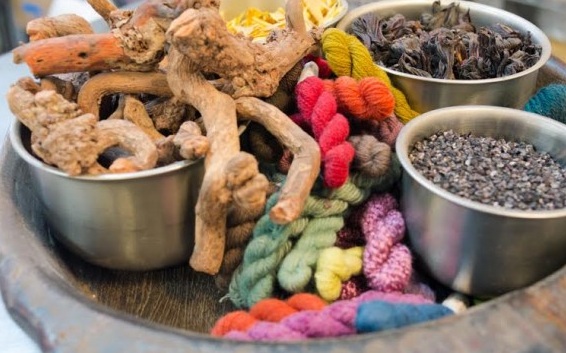We get asked so many questions about natural dyes that we put together 8 of our most frequently asked questions!
What are natural dyes?
Natural dyes are textile colorants that are derived from plants, insects and other natural materials. They are steeped in history, mystery and lore and each culture has its own set of prized colors, traditions and meanings. Prior to the mid-19th century, all dyes were from the natural world. Blue came from indigo, yellow from a variety of plants, including fustic, mignonette and dyers’ greenwood, red from madder roots and cochineal insects, purple from logwood and brown from walnut or cutch. These plants were gathered or harvested then chopped or crushed and soaked in water to release their colors. Recipes on how to achieve brilliant shades were closely held secrets and passed from generation to generation.
Are they safe?
Natural dyes are non-toxic, but they are not edible.
How are the dyes made?
Natural dyes come in a variety of formats. Whole natural dyestuffs must be prepared and soaked to make the plant color available and the soaking water becomes the dye bath. They are often used in a 1:1 ratio, requiring a large amount of dyestuff per pound of fabric. Natural dye extracts are concentrated powders or liquids that are easily dissolved in water and ready to add to the dye pot or dye machine. These concentrated dyes are typically much stronger than their raw dyestuff counterparts and thus far less concentrate is required.
What about mordants? Aren’t those toxic?
Natural dye mordants are mineral salts or tannic acid whose purpose is to chemically bind the natural dye to the fabric. Some of these substances such as copper and chrome are toxic and not recommended – ever. We do not use these mordants, nor do we support their use in textile dyeing. We only use the safest mordants and auxiliaries including alum, cream of tartar, iron and tannins. We always recommend the use of personal safety equipment such as face masks and gloves when handling powders and liquids.
Don’t natural dyes run and fade?
Any dye, either synthetic or natural that is improperly applied will run, streak, rub off or fade. Natural dyes perform comparably to synthetic dyes in washing and lightfast tests. The subtle highs and lows that come from natural dyes are considered part of their beauty and distinguish them from synthetic colors.
What about color repeatability?
Natural dyes are derived from plants and follow nature’s variations. However, it is possible to minimize color variations by careful dyeing and planning.
Is it possible to scale natural dyes?
We’ve worked for over 10 years with natural dyes in commercial dye houses. The dyes are produced in a concentrated extract form designed for industrial machinery. It’s now possible to dye hundreds of pieces at a time.
What is the impact of natural dyes?
The sustainability story about natural dyes is compelling. Many of the colors come from agricultural byproducts so that farmers are able to realize additional revenue from more of their harvest. Indigo is a legume and may be planted in rotation, enabling a farmer to grow a cash crop while enriching the soil. Natural dyes are a renewable resource and markedly different than synthetic dyes which come from petrochemical extraction sources.
For a full range of natural dyes for purchase, go here.

